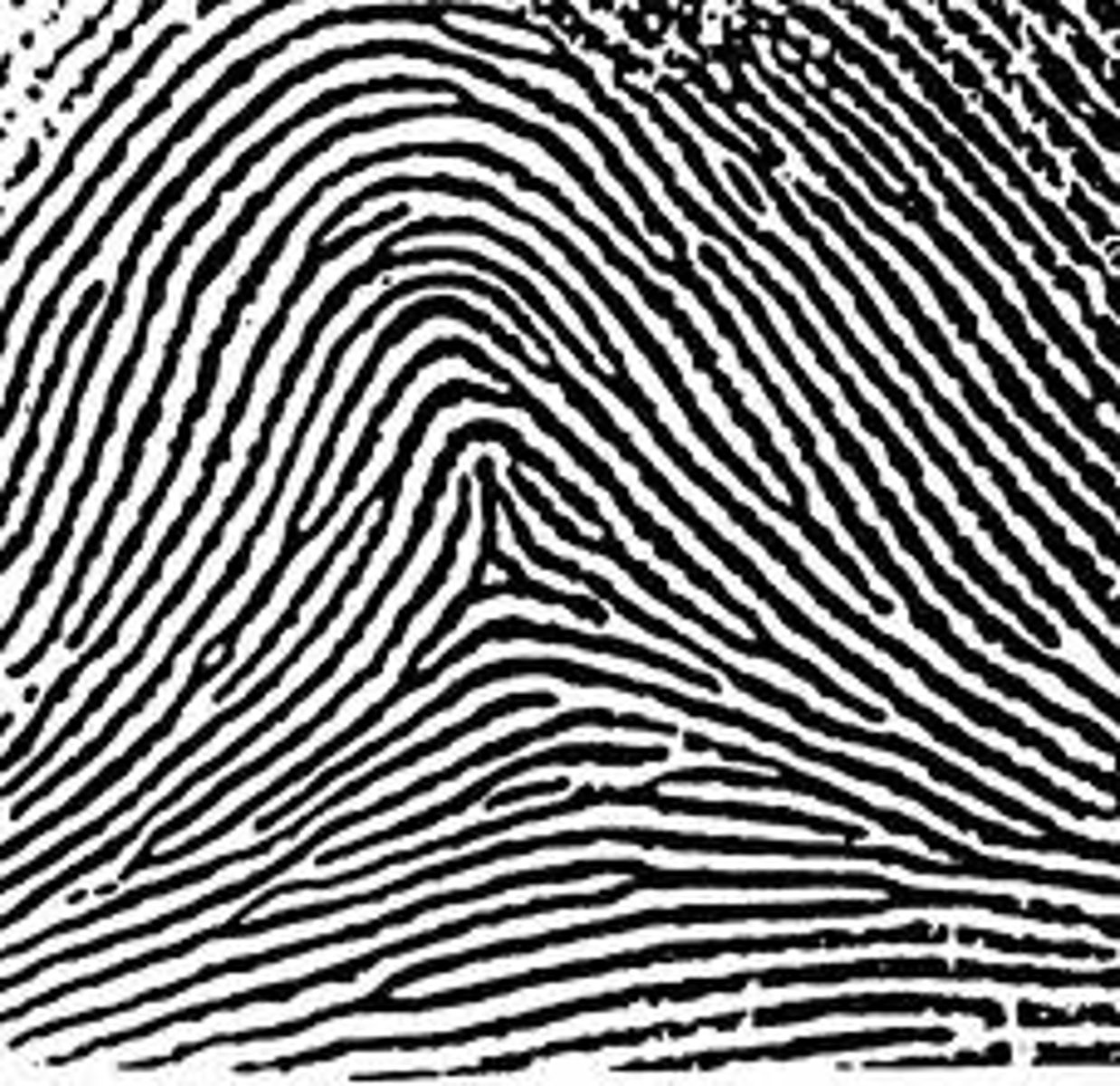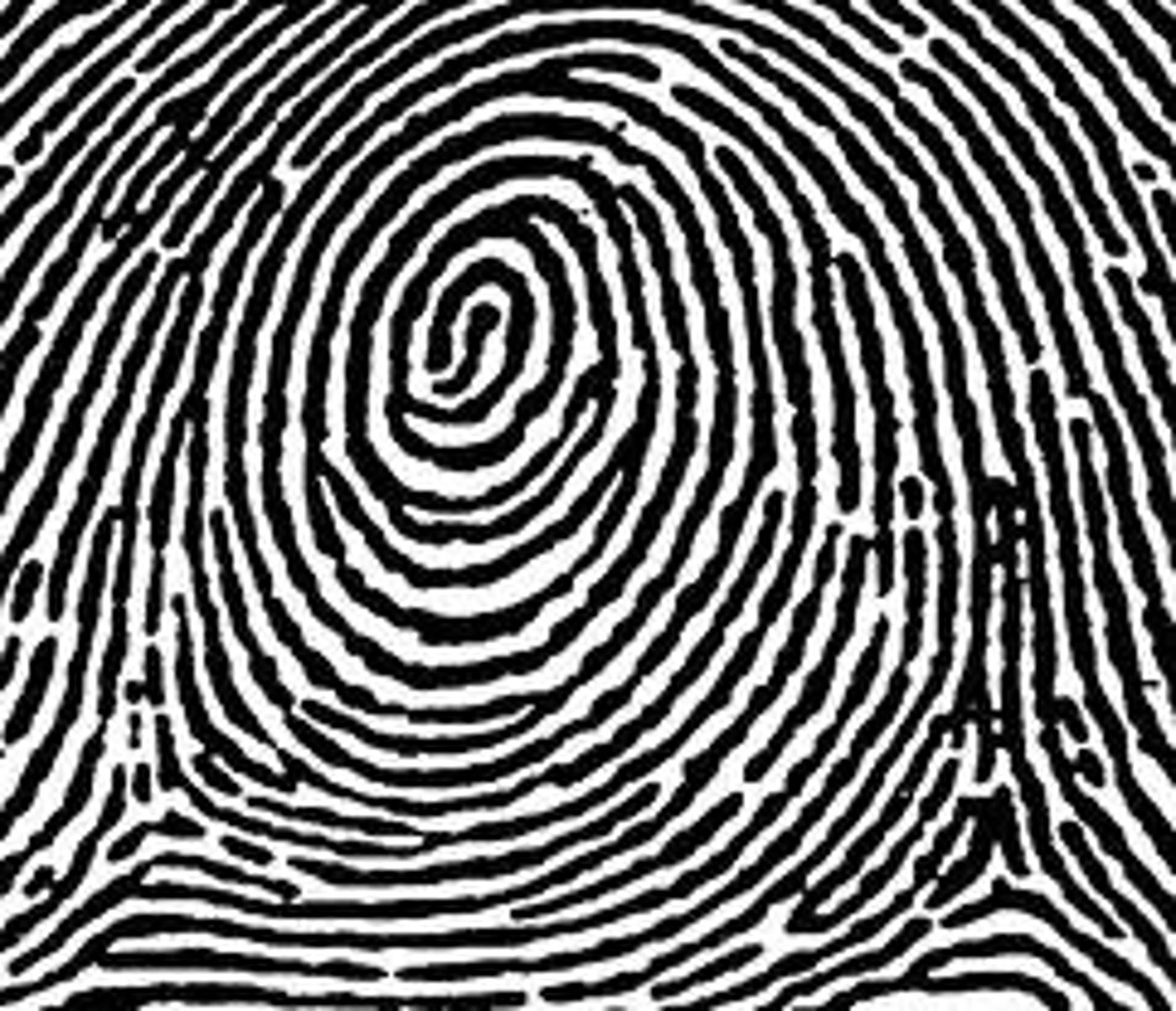PLTW: Biomedical Science Unit 1
1/103
There's no tags or description
Looks like no tags are added yet.
Name | Mastery | Learn | Test | Matching | Spaced |
|---|
No study sessions yet.
104 Terms
1st step to a crime scene investigation
1. Collect evidence
2nd step to a crime scene investigation
2. Sketch
3rd step to a crime scene investigation
3. Interview
4th step to a crime scene investigation
4. Examine
5th step to a crime scene investigation
5. Photograph
4 parts to a crime scene
sketch, legend, key, scale
3 primary fingerprint ridge patterns
arch, whorl, loop
arch fingerprint

whorl fingerprint

loop fingerprint

1st step to experimental design
1. Identify the problem or question
2nd step to experimental designs
2. Predict a solution to the problem or an answer to the question
3rd step to experimental designa
3. Design an experiment to test your hypothesis
4th step to experimental designv
4. Carry out the experiment
5th step to experimental designb
5. Analyze the data and observations
6th step to experimental designd
6. State the conclusion
7th step to experimental design
7. Summary paragraph
Independent variable
Variable that is varied or manipulated by the researcher
Dependent variable
Measurable effect, outcome, or response in which the research is interested
Biomedical Science
The application of the principles of the natural sciences, especially biology and physiology, to clinical medicine.
Control Group
The group in an experiment where the independent variable being tested is not applied so that it may serve as a standard for the comparison against the experimental group where the independent variable is applied.
Experiment
A research study conducted to determine the effect that one variable has upon another variable.
Forensic Science
The application of scientific knowledge to questions of civil and criminal law.
Hypothesis
Clear prediction of the anticipated results of an experiment.
Negative Control
Control group where conditions produce a negative outcome. Negative control groups help identify outside influences which may be present that were not accounted for when the procedure was created.
Personal Protective Equipment
Specialized clothing or equipment, worn by an employee for protection against infectious materials(as defined by OSHA).
Positive Control
Group expected to have a positve result, allowing the researcher to show that the experiment set up was capable of producing results.
Algor Mortis (T)
Cooling of the body to the surrounding temperature after death
Rigor Mortis (S)
Stiffness of the body that sets in several hours after death
Lividity
Helps determine the position of the body at time of death
The Glastier equation
98.4-recorded temp/1.5hours=Hours Since Death
Types of Blood
Type A, Type B, Type AB, Type O
Clumping with a serum that is Anti-A indicates
(same with Anti-B)
That the blood type has "A" in it
that the blood type has "B" in it
Cuticle
The cuticle is the outermost layer of the hair. It is consists of flattened, scale-like cells which overlap one another
microscopic characteristics associated with the cuticle, such as the thickness of the cuticle, the variation in the thickness, the presence of pigment, and the color. Also, the nature of the outer cuticle margin may be smooth, looped, ragged, or damaged.
Cortex
Home to pigment containing granules - gives hair color
Medulla
This layer may be continuous, discontinuous, fragmentary, or even absent. The diameter of the medulla is a useful characteristic in the identification and comparison process
Does the Glastier equation work for all ambient temperatures? Why or why not?
No, the Glastier equation does not work for all ambient temperatures because the hours since death is thrown off by very high or low temperatues.
What did the blood stain patterns left near Anna Garcia tell you about her death?
If blood is dropped from a higher height, then the blood spatter diameter increases as a result of the kinetic energy and force of gravity as blood falls to the Earth. (The blood at the crime scene was dropped from table height)
Adenine
A component of the nucleic acids, energy-carrying molecules such as ATP, and certain conenzymes. Chemically, it is a purine base.
Chromosome
Any of the usually linear bodies in the cell nucleus that contain the genetic material.
Cytosine
A component of nucleic acids that carry hereditary information in DNA and RNA in cells. Chemically, it is a pyrimidine base.
Deoxyribonucleic Acid (DNA)
A double-stranded, helical nucleic acid molecule capable of replicating and determining the inherited structure of a cell's proteins.
Gel Electrophoresis
The separation of nucleic acids or proteins, on the basis of their size and electrical charge, by measuring their rate of movement through an electical field in a gel.
Gene
A discrete unit of hereditary information consisting of a specific nucleotide sequence in DNA (or RNA, in some viruses).
Guanine
A component of nucleic acids that carry hereditary information in DNA and RNA in cells. Chemically, it is a purine base.
Helix
Something spiral in form.
Model
A simplified version of something complex used, for example, to analyze and solve problems or make predictions.
Nucleotide
A building block of DNA, consisting of a five-carbon sugar covalently bonded to a nitrogenous base and a phosphate group.
How do scientists isolate DNA to study it?
DNA can be extracted from cells by
1. obtaining cells
2. using detergent to break down the cell and nuclear membranes
3. adding isopropyl alcohol to separate the rest of the cellular materials
How does DNA differ from person to person?
Only the sequence and number of bases separates all organisms.
Human DNA differs only between humans of 0.1%
only identical twins have the same DNA sequence
Restriction Enzyme
A degradative enzyme that recognizes specific nucleotide sequences and cuts up DNA.
Restriction Fragment Length Polymorphisms (RFLPs)
Difference in DNA sequence on homologous chromosomes that can result in different patterns of restriction fragment lengths (DNA segments resulting from treatment with restriction enzymes).
Thymine
A component of nucleic acids that carry hereditary information in DNA and RNA in cells. Chemically, it is a pyrimidine base.
Autopsy
An examination of the body after death usually with such dissection as will expose the vital organs for determining the cause of death.
Bibliography
A document showing all the sources used to research information.
Citation
A written reference to a specific work (book, article, dissertation, report, musical composition, etc.) by a particular author or creator which identifies the document in which the work may be found.
Documentation
The act of creating citations to identify resources used in writing a work
Medical Examiner
A physician who performs an autospy when death may be accidental or violent. He or she may also serve in some jurisdictions as the coroner.
Autopsies are performed in which 4 circumstances
1. Unexpected deaths/death when not under medical treatment 2. Death resulting from any type of injury 3. Suspicious circumstances 4. Other circumstances as outlined by state laws
What medical profession performs autopsies?
Forensic pathologist (medical examiner)
5 manners of death
1. natural 2. accident 3. suicide 4. homicide 5. undetermined
Forensic autopsy
Try to find cause of death for police investigation
Clinical Autopsy
Usually performed in hospitals, determines cause of death for study purposes
Forensic Medical Examiner
● Examine human bodies from people who pass away
● Look into the medical history of the deceased
● Look at the crime scene
● Look at statements from witnesses
● Create and prepare reports
Toxicologist
● Develops and coordinates regulatory programs for consumer products
● Conducts research on toxic effects of consumer products and ingredients on laboratory animals for manufacturers of consumer products
Morgue Assistant
● Receives bodies of deceased patients
● Helps place bodies in compartment trays
● Confirms identification of bodies
● Releases bodies as appropriate
● May assist pathologist in performing autopsies
911 OPERATOR
• Questioning callers to determine their location and the nature of the emergency
• Receiving incoming telephone calls regarding fire, police and emergency medical services
• Determining response requirements and placing priorities on situations
• Recording details of all calls, dispatches and messages
• Retrieving and entering data from teletype networks and computerized data systems
• Contacting emergency response field units to determine their availability for dispatch
EMERGENCY MEDICAL TECHNICIAN (EMT)
• How to operate emergency equipment
• Extricating patients from wrecked vehicles
CRIME SCENE INVESTIGATOR
• Analyze and document evidence
What were the 5 powders found at the crime scene?
Cocaine, Acetaminophen, Acetylsalicylic Acid (aspirin), Methamphetamine, and Ecstasy
What was the unknown substance found at the crime scene?
Acetylsalicylic Acid (aspirin)
What is Anna's blood type?
B+
What is Alex's blood type?
B+
What is Erica's blood type?
A+
What is Lucy's blood type?
B+
What is Doug's blood type?
AB+
The blood found at the crime scene belonged to
Alex or Anna
The hair found at the crime scene belonged to
Anna Garcia
The medulla is inside
The cortex
What is the outermost layer of a piece of hair?
The cuticle
The ridge pattern category for Alex Garcia
Radial Loop and Forks
The ridge pattern category for Doug Greene
Plain Arch and Hooks
The ridge pattern category for Erica Piedmont
Radial Loop and Forks
The ridge pattern category for Lucy Leffingwell
Radial Loop and Eye
The ridge pattern category for Anna Garcia
Whorl and Forks
The fingerprint found at the crime scene belonged to
Alex Garcia
The shoeprint found at the crime scene belongs to
Anna Garcia
What time did Anna die?
Around 7 a.m.
BLOOD SPLATTER ANALYST
● Taking photographs
● Using swabs and ultraviolent light to detect and collect trace evidence
● Recreating spatter in the lab
● Creating detailed reports using computer simulations and analysis
● Reporting findings to colleagues, law enforcement professionals, and court officials
What is one of the main challenges of knowing if evidence is reliable?
The evidence could have been tampered with or contaminated by bacteria or other animals
How many rings do purines have in their structure?
2
How many rings do pyrimidines have in their structure?
1
Why do purines bond with pyrimidines in the DNA ladder?
Each purine has a complementary base pair with a pyrimidine due to the number of bonds they each have
Why does adenine bond with thymine?
Adenine, a purine, and thymine, a pyrimidine, bond with each other because they both have two hydrogen bonds
Why does guanine bond with cytosine?
Guanine, a purine, bonds with cytosine, a pyrimidine, because they both have three hydrogen bonds
FORENSIC DNA ANALYST
● Analyzing evidence that can link suspects with specific crime scenes
● Identifying samples of DNA, such as blood, hair follicles, or other bodily fluids
The DNA found at the crime scene belonged to
Anna Garcia
How are restriction enzymes used?
Restriction Enzymes are used to cut DNA into small strands
How is gel electrophoresis used?
Gel electrophoresis separates the DNA strands by size
Cause of Death-
The disease or injury that initiated the train of morbid events leading directly to death or the circumstances of the accident or violence that produced the injury